| MI-17 MULTIROLE HELICOPTER
MI-17多任务直升飞机 Date:2017-02-18 Source:Internet By:Globalmil Viewed: |
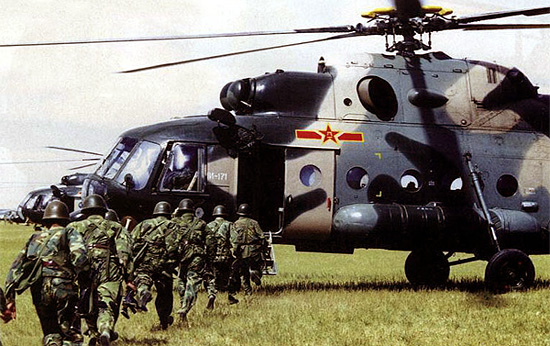
The introduction of the Mi-17 series helicopters has greatly increased the mobility of the PLA ground forces. Showing in this photo are the PLA ground troops being airlifted by Mi-171 helicopters in exercise.
Mi-17系列直升飞机的引进大幅地增加PLA地面部队机动性。在这一张相片中表现是在演习中PLA地面部队被Mi-171直升飞机空运。
The Mi-17 series multirole helicopter (NATO codename: Hip-H) is the upgraded export variant of the Mi-8 Hip utility helicopter originally introduced by the Mil Design Bureau in the 1960s. The PLA Army Aviation Corps currently operates over 200 machines of the Mi-17 in four variants: Mi-17, Mi-171, Mi-17V-5, and Mi-17V-7. It appears that China is not interested in the local production of the helicopter under license, but the PLA may need to purchase more Mi-17s before an indigenously built alternative becomes available.
MI-17系列多任务直升飞机(北约代号:“河马”(Hip)-H)是升级的外销型MI-8“河马”(Hip)通用直升飞机,在1960年由Mil设计局推出。PLA陆军航空兵操作超过200架MI-17的四种改型:MI-17、MI-171、MI-17V-5、MI-17V-7。看来中国没有对在许可下本国制造直升飞机感兴趣,但是在本国制造的替代选择变成可供应之前,PLA可能购买更多的MI-17。

The PLA Army Aviation currently operates over 200 Mi-17 series helicopters in four variants: Mi-17, Mi-171, Mi-17V-5 and Mi-17V-7.
PLA陆军航空兵现在操作超过200架四种改型的Mi-17系列直升飞机:Mi-17、Mi-171、Mi-17V-5和Mi-17V-7。
PROGRAMME
计划
The PLA began to seek a new modern transport/utility helicopter in the late 1980s as its ageing Z-5 (Mi-4 Hound) fleet retired from active duties. The US-led arms embargo following the 1989 incident closed off further supply of the Sikorsky S-70C and curtailed access to European helicopters, while the domestic helicopter development was slow. However, the end of the Cold War and the restoration of China’s relation with the Soviet Union/Russia provided the PLA with an alternative source for advanced weapon systems.
PLA在1980年后期,当它的陈旧Z-5(MI-4“猎犬”(Hound)) 机群从现役退役,开始寻求一种新的现代化运送/通用直升飞机。美国在1989年之后领导武器禁运的事件关闭了西科尔斯基(Sikorsky)S-70C的进一步的供给,而且截断了对欧洲的直升飞机的获得,当时中国国内直升飞机发展缓慢。然而,冷战结束和中国恢复与苏联/俄国的关系为先进的武器系统给PLA提供一个交替来源。
In 1990 China ordered 24 Mi-17 transport helicopters from Russia and received them in 1991. The deal started the multibillion arms transfer between the two countries in the following decades. In 1995, the PLA ordered another 60 improved variant Mi-171 helicopters, which were delivered in 1997. By early 2003 the PLA had received about 191 of Mi-17, Mi-171 and Mi-17V-5 helicopters. This figure increased to 216 with the order of 25 new Kazan-built M-17V-7 variants in 2003/04.
在1990年中国从俄国订购了24架Mi-17直升飞机和在1991年接收到了它们。交易启动了两个国家间随后十年数百亿美元的武器转移。在1995年,PLA订购另外的60架改进型MI-171直升飞机,在1997年交付。在2003年初之前,PLA已经接收到MI-17,MI-171和MI-17V-5中的约 191架直升飞机。这一个数字由于在2003/04年订购25架新的Kazan制造的M-17V-7改型增加到216架。
Recent purchases have shifted to the Mi-17-V5 version built by the Kazan Helicopter Plant JSC located in Kazan. These variants feature a new “dolphin” nose, more powerful TV3-117VM engine with new auxiliary power unit, an extra port door on the starboard side, and flat rear fuselage ramp for easier access. In 2003 the PLA ordered 24 further improved Mi-17V-7 variant, which features a more powerful VK-2500 engine and greater payload and range. These will be more suited to high-altitude work in Tibet.
最近的购买已经改变到由位于Kazan的Kazan直升飞机厂 JSC制造的Mi-17V5型。这些改型以一个新的“海豚”机鼻为特色,更大功率的TV3-117VM发动机和新的辅助动力装置,在右舷的一扇额外的舱门,和扁平的后机身用于比较容易进入。在2003年PLA订购24架更进一步改良的Mi-17V-7改型,特点是采用一台更大功率的VK-2500发动机和更大的负载和航程。这些将会更适合到西藏的高空工作。
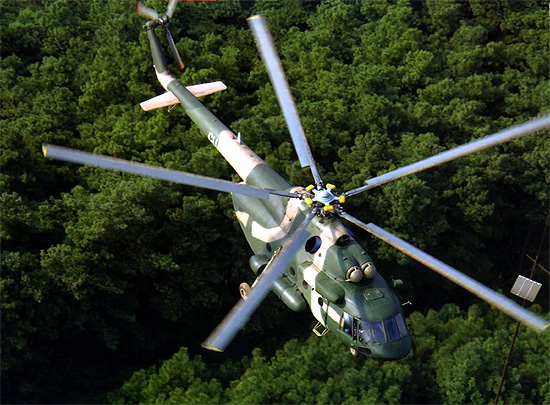
Recent purchase have been shifted to the Kazan factory’s Mi-17V-7 model which features more powerful VK-2500 engines and greater payload and range, which make the helicopter particularly suitable for flight in highland and harsh weather conditions regions such as Tibet.
最近的购买已经改变到喀山直升飞机厂Mi-17V-7型,具有更高功率的VK-2500发动机和更大的负载和航程为特点,使飞机特别适合用于飞行在高原和恶劣天气状况地区,像是西藏。
The Mi-17 series provided the PLA with a robust, versatile helicopter for personnel/cargo transport, airmobile and assault operations, close air support, mine laying, airborne command post, medical evacuation, and search and rescue roles. The Mi-17s sold to the PLA were unarmed but the PLA managed to fit them with external pylons for carrying machinegun pods, 57/68mm unguided rocket launchers, 250/500kg bombs, and fuel tanks. However, unlike the Mi-8TV armed helicopters in service with the Russian Army, the Mi-17s in service with the PLA lack the cockpit armour protection, chaff launchers, engine IR suppressors, and the ability to launch anti-tank guided missiles (ATGM).
Mi-17系列提供PLA使用一种坚固的、通用直升飞机用于人员/货物运输、空中机动部队和袭击军事行动,近距离空中支援、布雷、空中指挥站、医疗撤退和搜寻/援救任务。出售给PLA的Mi-17为非武装型,但是PLA设法安装它们在外挂架携带机炮吊舱、57/68毫米非制导火箭发射装置、250/500公斤炸弹和燃料箱。然而,不像 在俄罗斯陆军服役的Mi-8TV武装直升飞机,在PLA服役的Mi-17缺乏座舱装甲保护、箔条发射器、发动机IR抑制器和有能力发射反坦克导弹(ATGM)。
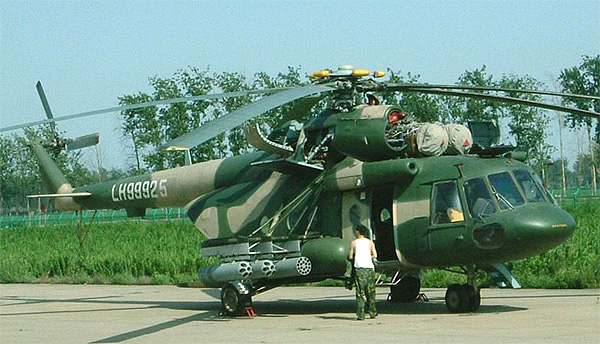
The Mi-17 helicopters sold to China were unarmed but the PLA fitted them with external pylons for carrying machinegun pods, 57/68mm unguided rocket launchers, 250/500kg bombs, and fuel tanks.
出售给PLA的Mi-17为非武装型,但是PLA设法安装它们在外挂架携带机炮吊舱、57/68毫米非制导火箭发射装置、250/500公斤炸弹和燃料箱。
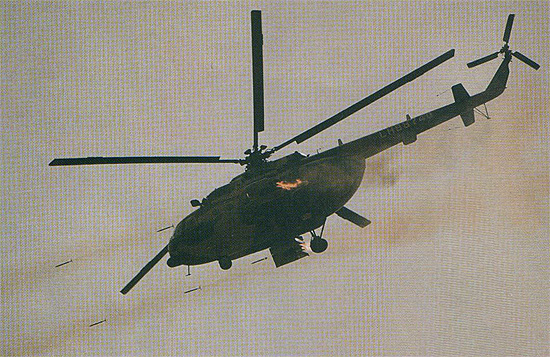
PLA Mi-171 helicopter launching unguided rockets for close air support role. Although the Mi-17 series helicopters in service with the PLA have been modified to carry weapons, they do not possess precision strike capability like the M-8AT in service with the Russian Army.
PLA的Mi-171直升飞机为近距离空中支援任务发射非制导火箭。虽然Mi-17系列直升飞机在PLA服役中已经被修改携带武器,它们不具有像俄国军队服役中的M-8AT一样的精确打击能力。
DESIGNS
设计
设计
The Mi-17 helicopter has a conventional design, with a five-bladed main rotor, a three-bladed tail rotor, and fixed tricycle nose-wheel landing gear. The aircrew include pilot, co-pilot/navigator, and flight mechanic. The cockpit and the main cabin are heated with air condition as optional. The helicopter is also fitted with fire suppression and de-icing system to increase its survivability. The helicopter is also fitted with an electrically operated hoist (200kg) for search and rescue missions.
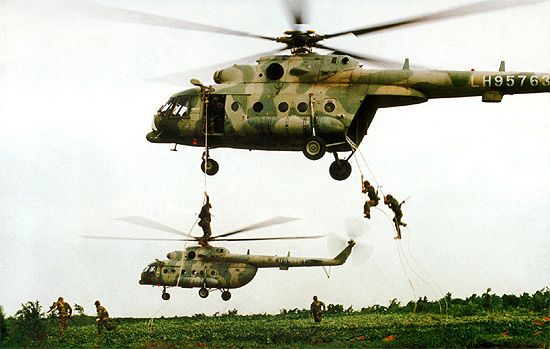
Mi-17 helicopters in service with the PLA have also been modified to carry a range of special duties including mine laying, airborne command post, medical evacuation, and search and rescue.
Mi-17直升飞机在PLA服役中已经被修改去支持多种专用职责包括布雷、空中指挥站、医疗撤退,搜索和援救。
Mi-17直升飞机采用一种传统设计,五浆叶主旋翼,三浆叶尾旋翼和固定前三点起落架。全体人员包括驾驶员、副驾驶员/导航员和飞行机师。驾驶座舱和主机舱加热使用空调可供选择。直升飞机也配备有灭火抑制象、和除冰系统去增加它的生存性。直升飞机也配备有一部电动吊车(200公斤)用于搜索和援救任务。

Mi-17 helicopters in service with the PLA have also been modified to carry a range of special duties including mine laying, airborne command post, medical evacuation, and search and rescue.
Mi-17直升飞机在PLA服役中已经被修改去支持多种专用职责包括布雷、空中指挥站、医疗撤退,搜索和援救。
Early variants are fitted with two side-hinged clamshell rear cargo doors, but these are replaced by a single flat ramp for easier access.
早期改型配备有双侧铰链蛤壳形后货物门,但是这被一个单扇斜坡门代替为了比较容易进入。
ENGINES
发动机
The Mi-17/171 is fitted with two improved TV3-117 MT engines. The Mi-17V5 is fitted with two improved TV3-117 VM engines for greater performance. The helicopter can take-off with one engine shut down. A new auxiliary power unit (APU) enables engine starts at altitudes up to 6,000m.
Mi-17/171配备有二台改进的TV3-117MT发动机。Mi-17V5为更好的性能配备有二台改进的TV3-117VM发动机。直升飞机能在一台发动机停转下起飞。一台新的辅助动力单位(APU)在高度达到6,000米使发动机启动。
The helicopter carries 1,870 litres of fuel in two flexible internal tanks and two external tanks. The total fuel capacity can be increased to 3,700 litres by installing up to two ferry tanks in the cabin. Some Mi-17/171s in service with the PLA are seen being fitted with internal and external fuel tanks for longer range.
直升飞机在二个可调节内部油箱和二个外部油箱携带1,870升燃料。在机舱中至多安装二个转场油箱总燃料容量能增加到3,700升。一些在PLA服役中的Mi-17/171被看到为较远的航程配备有内部和外部燃料箱。
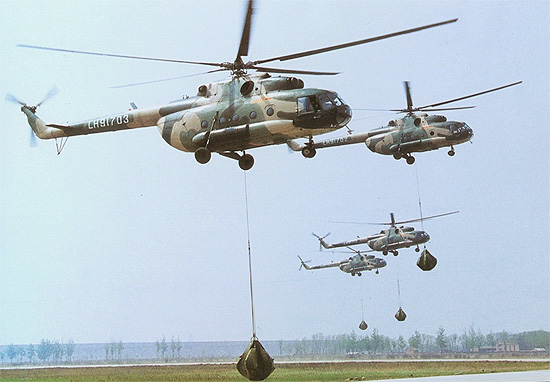
The Mi-17 series helicopters are fitted with cargo hook for external lift missions.
Mi-17系列直升飞机安装使用吊货钩用于外部提升。
FUTURE UPGRADES
未来升级
One deficiency for the PLA’s Mi-17/171s is a lack of electronic countermeasures (ECM) devices. One report suggests that Israel has been trying to prompt its EW/ECM upgrade package for the Mi-17 series helicopters.
用于PLA的Mi-17/171存在不足,缺乏电子干扰(ECM)装置。一个报告以色列已经试着交付它的电子战(EW)/电子干扰(ECM)升级组件用于Mi-17系列直升飞机。
SPECIFICATIONS
规格
规格
|
|
|
|
|
|
|
| 动力装置型号(Powerplant Model) | TV2-117A | TV3-117MT | TV3-117MT | TV3-117VM | VK-2500 |
| 最大重量(Max Weight) | 12,000kg | 13,000kg | 13,000kg | 13,000kg | 14,000kg |
| 负载(Payload) (int/ext) | 4t/3t | 4t/4t | 4t/4t | 4t/5t | 5t/6t |
| 航程(Range) | 464km | 690km | 690km | 590km | 890km |
| 乘客(Passenger) | 24 | 30 | 30 | 30~40 | 30~40 |
| 服役数量(Number in service) | ~30 | 24 | 90 | 20+ | 25 |
Crew: Three (Pilot, navigator and flight mechanic)
Dimensions: Length (Without rotors): 18.22m; Height (Without rotors): 5.7m; Width (Without rotors): 2.5m
Blades: Main rotor 5; tail rotor 3
Normal Take-Off Weight: 11,100kg
Maximum Take-Off Weight: 12,000kg
Normal Payload: 2,355kg
Maximum Payload: 4,000kg
Cargo Payload: Internal load 4,000kg; external on sling only 3,000kg; transports 24 troops and cargo, or armaments on six external hardpoints
Maximum Speed: 250km/h
Cruising Speed: 240km/h
Service Ceiling: 5,000 to 5,700m (variant dependant)
Hover Ceiling (out of ground effect): 1,760m
Hover Ceiling (in ground effect): 1,900 to 3,980m (variant dependant)
Range: (Normal) 495km; (With external tanks) 1,095km
组员: 三名(驾驶员、导航员和飞行机师)
尺寸: 长度(没有旋翼)18.22 米;高度:(没有旋翼) 5.7 米;宽度:(没有旋翼)2.5 米
浆叶: 主旋翼 5、尾旋翼 3
正常起飞重量: 11,100 公斤
最大的起飞重量: 12,000 公斤
正常负载量: 2,355 公斤
最大的负载量: 4,000 公斤
货物负载量:内部负载 4,000 公斤;在外部吊挂仅仅3,000 公斤;运送4名军人和货物,或在六外部硬挂点上装备
最大速度: 250 公里/小时
巡航速度: 240 公里/小时
实用升限: 5,000到5,700 米(改型垂悬)
盘旋升限:(没有地效) 1,760 米
盘旋升限:(在地效中)1,900 到 3,980 米(改型垂悬)
航程:(正常)495 公里;(使用外部燃料箱)1,095 公里
上一篇:Zhi-15 (EC 175) Medium Helicopter 下一篇:Harbin Z-19
| Changhe Z-18
中国昌河Z-18型直升机 |
| The Changhe Z-18 is a medium transport helicopter developed by Changhe Aircraft Industries Corporation (CAIC) to replace the Z-8.... [2017-07-09] |
| Harbin Z-20
中国哈尔滨Z-20型中型直升机 |
| The Harbin Z-20 or Zhi-20 is a medium lift helicopter produced in the Northeast of China.... [2017-07-09] |
| Harbin Z-19E makes maiden flight targeting export market
哈尔滨Z-19E型武装直升机完成首飞瞄准外销市场 |
| The Z-19E is generally comparable in performance and capability to the later variants of the AH-1 HueyCobra, and is particularly for low-intensity conflicts, counterterrorism, and counter-insurgency operations.... [2017-06-29] |
| Harbin Z-19
中国哈尔滨Z-19型武装直升机 |
| The Z-19 is an updated modified version of the Harbin Z-9W. It is a twin-seat tandem helicopter using commercial components from the Eurocopter AS365 Dauphin series as the Z-9 series which are licence-built versions of the Dauphin.... [2017-06-28] |
